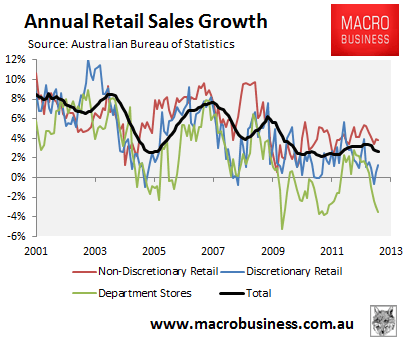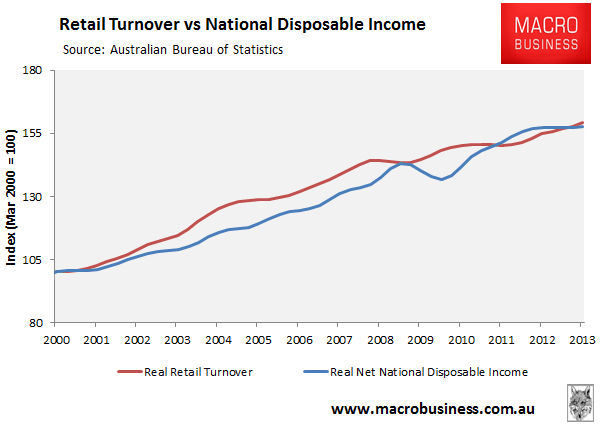
It has been well documented on this site that Australia’s discretionary retailers – and department stores in particular – are doing it tough. Whereas overall retail sales have managed to at least track inflation, led by solid growth in food retailing, overall discretionary retail remains in the gutter, with department store sales growth turning sharply negative over recent months (see next chart).

The cause of discretionary retail’s malaise are many. For example, there’s the “cautious consumer” – effectively the realisation that consumers won’t borrow and spend in the manner that they did prior to the Global Financial Crisis (GFC). There’s also the rise of internet shopping, and the increasing degree to which consumers buy goods from offshore.
Unfortunately for Australia’s discretionary retailers, their landlords have been slow to recognise these trends and have, for a number of years, lifted rents well above sales growth. This has squeezed retail margins, putting the sector under even greater strain.
Thankfully, times seem to be changing, with retail landlords belatedly coming to the realisation that they cannot continue to lift rents unreasonably, as the retail sector can no longer sustain it. So retail landlords are now tapering rent increases across suburban shopping malls, although prime CBD locations are still attracting strong rental growth:
…a new report from Citi analysts suggests the tide is turning in favour of specialty retailers. Citi’s Craig Woolford forecasts that retail rents, which have far outpaced sales growth, will grow much more slowly over the next three years at a rate closer to 2 per cent a year.
Woolford estimates that a typical retail lease signed in 2009 has had a cumulative rental increase of 19 per cent, while the store’s actual sales have fallen by 6 per cent, based on industry averages. Those onerous leases signed from 2009 to 2011 will start rolling off next year.
Average growth in non-food retail sales has been recession-like over the past three years at 1.3 per cent annual growth, compared with the 25-year average of 4.7 per cent…
More modest rental costs in shopping malls around the country will be one small consolation for struggling retailers, particularly on the clothing front. With the Aussie dollar sitting comfortably in the mid-90 US cent range, shopping offshore at online stores remains affordable and does not appear to have fallen off as much as expected when the dollar fell below parity.
With the imminent arrival of Uniqlo and H&M in Melbourne adding to the influx of international brands offering a vast range of well-priced fashion, smaller retailers need all the help they can get.
There are strong reasons to believe that discretionary retail sales growth will remain soft in the years ahead, which will continue to pressure rents.
First, one of the key drivers of the strong growth in retail sales over the 1990s and 2000s was the inexorable rise in household debt and the run-down of household savings (see below charts).
Household debt levels stabilised from 2006, whereas household savings rates have returned to long-run historical norms, suggesting that sales growth can only grow in line with disposable incomes going forward.
On this front, the news is also bad for the retail industry. As explained previously, the growth in household disposable incomes over the 2000s was extraordinary, driven by the once-in-a-century surge in commodity prices and the terms-of-trade. As the terms-of-trade retraces back towards its longer-run average, it will detract from income growth, pulling down consumption and retail sales in the process.
The next chart is instructive. Despite five years of sluggish retail growth, overall retail sales have still managed to grow at a faster rate than incomes since 2000 – incomes that were highly inflated by the one-off boom in commodity prices (see next chart).

In short, the prior decade’s retail sales growth was extraordinary, driven by the huge surge in household debt and the once-in-a-century boom in incomes. The situation was unsustainable and the retail industry is unlikely to experience anywhere near these levels of sales growth in the decade ahead.

